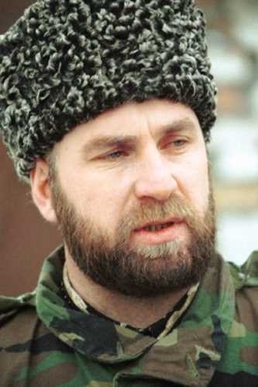Related Research Articles

The Second Chechen War took place in Chechnya and the border regions of the North Caucasus between the Russian Federation and the Chechen Republic of Ichkeria, from August 1999 to April 2009.

On 19 August 2002, a group of Chechen fighters armed with a man-portable air-defense system brought down a Russian Mil Mi-26 helicopter in a minefield, which resulted in the death of 127 Russian soldiers in the greatest loss of life in the history of helicopter aviation. It was also the most deadly aviation disaster ever suffered by the Russian Armed Forces, as well as its worst loss of life in a single day since the 1999 start of the Second Chechen War.

Hamzat (Ruslan) Gelayev (Russian: Хамзат Гелаев; Chechen: ГелаевгIеран Германи-воI Хамзат, romanized: Gelaevhervan Germanivol Hamzat was a prominent commander in the Chechen resistance movement against Russia, in which he played a significant, yet controversial, military and political role in the 1990s and early 2000s. Gelayev was commonly viewed as an abrek and a well-respected, ruthless fighter. His operations spread well beyond the borders of Chechnya and even outside the Russian Federation and into Georgia. He was killed while leading a raid into the Russian Republic of Dagestan in 2004.

The 1999–2000 battle of Grozny was the siege and assault of the Chechen capital Grozny by Russian forces, lasting from late 1999 to early 2000. This siege and assault of the Chechen capital resulted in the widespread devastation of Grozny. In 2003, the United Nations designated Grozny as the most destroyed city on Earth due to the extensive damage it suffered. The battle had a devastating impact on the civilian population. It is estimated that between 5,000 and 8,000 civilians were killed during the siege, making it the bloodiest episode of the Second Chechen War.
Human rights violations were committed by the warring sides during the second war in Chechnya. Both Russian officials and Chechen rebels have been regularly and repeatedly accused of committing war crimes including kidnapping, torture, murder, hostage taking, looting, rape, decapitation, and assorted other breaches of the law of war. International and humanitarian organizations, including the Council of Europe and Amnesty International, have criticized both sides of the conflict for blatant and sustained violations of international humanitarian law.
In June 2000, the North Caucasian Chechen separatist-led Chechen insurgents added suicide bombing to their tactics in their struggle against Russia. Since then, there have been dozens of suicide attacks within and outside the republic of Chechnya, resulting in thousands of casualties among Russian security personnel and civilians. The profiles of the suicide bombers have varied, as have the circumstances surrounding the bombings.
In the Battle of Grozny of August 1996, also known as Operation Jihad or Operation Zero Option, when Chechen fighters regained and then kept control of Chechnya's capital Grozny in a surprise raid. The Russian Federation had conquered the city in a previous battle for Grozny that ended in February 1995 and subsequently posted a large garrison of federal and republican Ministry of the Interior (MVD) troops in the city.
The November 1994 Battle of Grozny was a covert attempt by Russian Intelligence services to oust the Chechen government of Dzhokhar Dudayev, by seizing the Chechen capital of Grozny. The attack was conducted by armed formations of the opposition Provisional Council, led by Umar Avturkhanov, with a clandestine support of Russian Federation armor and aircraft on 26 November 1994. The fighting subsided after the first 10 hours, with the Chechen Republic of Ichkeria decisively repelling the assault.
The Grozny OMON fratricide incident took place on March 2, 2000, when an OMON unit from Podolsk, supported by paramilitary police from the Sverdlovsk Oblast in armored vehicles, opened fire on a motorized column of OMON from Sergiyev Posad, which had just arrived in Chechnya to replace them.
The Battle of Komsomolskoye took place in March 2000 between Russian federal forces and Chechen separatists in the Chechen village of Komsomolskoye (Saadi-Kotar), Chechnya. It was the largest Russian victory during the Second Chechen War. Several hundred Chechen rebel fighters and more than 50 Russian servicemen were killed in the course of more than two weeks of siege warfare. An unknown number of civilians were killed in the fighting as well. The fighting resulted in the destruction of most of the forces of Chechen rebel field commander Ruslan Gelayev. Scores of Chechens were taken prisoner by the Russians, and only a few survived. A number of civilians died from torture, and the village was looted and destroyed.
References
- ↑ ISN Security Watch – 200'000 killed in Chechnya in 10 years
- ↑ "CNN.com - Breaking News, U.S., World, Weather, Entertainment & Video News". Archived from the original on 13 February 2008. Retrieved 14 December 2014.
- ↑ "Programs - The Jamestown Foundation". Archived from the original on 19 September 2006. Retrieved 14 December 2014.
- ↑ "CNN.com - Breaking News, U.S., World, Weather, Entertainment & Video News". Archived from the original on 9 February 2008. Retrieved 14 December 2014.
- ↑ Chechen rebels kill eight in clashes
- ↑ "CNN.com - Breaking News, U.S., World, Weather, Entertainment & Video News". Archived from the original on 9 February 2008. Retrieved 14 December 2014.
- ↑ "BBC NEWS - Europe - Russian helicopter 'downed' in Chechnya". 29 October 2002. Retrieved 14 December 2014.
- ↑ "General Killed in Grozny Gun Attack" . Retrieved 14 December 2014.